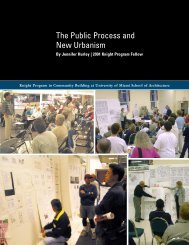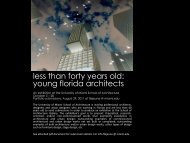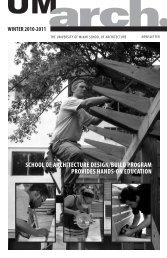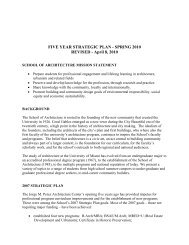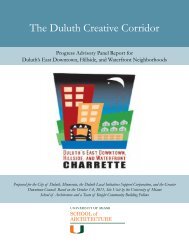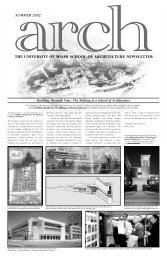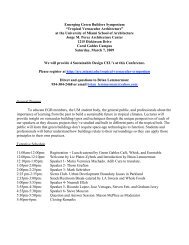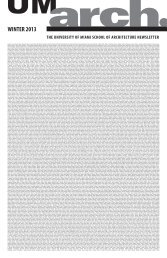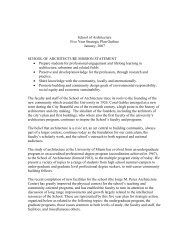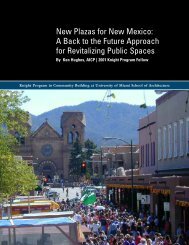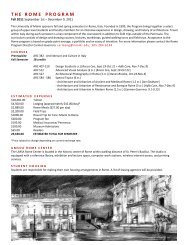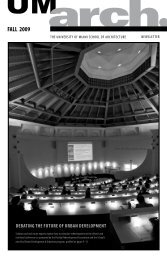Resilience - University of Miami School of Architecture
Resilience - University of Miami School of Architecture
Resilience - University of Miami School of Architecture
You also want an ePaper? Increase the reach of your titles
YUMPU automatically turns print PDFs into web optimized ePapers that Google loves.
28<br />
virginia key ecosystem<br />
urban<br />
• How can beer physical connecons be made to adjacent instu-<br />
ons?<br />
• How can the RSMAS campus be opened up and integrated into the<br />
system <strong>of</strong> public waterfront trails which runs from Brickell, out the<br />
Rickenbacker Causeway, and onto Crandon Park?<br />
• How could campus edges be redeveloped to funcon as es, rather<br />
than barriers to adjacent uses?<br />
ecological<br />
• What funcons <strong>of</strong> the system have been most compromised by<br />
coastal development?<br />
• What <strong>of</strong>f-site impacts does the campus have?<br />
• What adverse impacts could be migated through architectural or<br />
site improvements?<br />
• What campus improvements could contribute to increased funcon<br />
or resilience <strong>of</strong> the ecosystem?<br />
building resilience<br />
sea-level Rise<br />
The concept <strong>of</strong> resilience has several implicaons in terms <strong>of</strong> evaluang the<br />
architecture itself. Most obvious is physical resilience to climate events including<br />
hurricanes and sea-level rise. Examples from other low-lying geographies<br />
are informave, but South Florida presents an unusual set <strong>of</strong> condions.<br />
Dutch architecture represents a cultural bias toward long planning horizons<br />
and durable, well detailed architecture. These qualies are appropriate to<br />
planning for university structures which are expected to accommodate sophiscated<br />
program requirements and endure over me. However, hurricane<br />
winds, intense sun, and humidity add addional stresses not considered in<br />
Dutch architecture. Coastal developments in Southeast Asia do face similar<br />
climate condions, yet few examples are expected to meet the high performance<br />
standards <strong>of</strong> <strong>University</strong>-level research facilies.<br />
thermal comfort<br />
Ability to provide climate comfort through passive or renewable means is another<br />
aspect <strong>of</strong> resilience. Again, Southeast Asia provides some precedents.<br />
Integrang tradional strategies into a high-performance building will be part<br />
<strong>of</strong> the challenge. Ideally, a combinaon <strong>of</strong> passive thermal comfort strategies,<br />
efficient building envelope, minimizing arficial lighng demand, and<br />
thoughul design <strong>of</strong> specialized laboratory equipment could result in a high<br />
performance research building which could operate with less dependence on<br />
outside power. While this seems unusual for a university building, there are<br />
many examples <strong>of</strong> field research facilies which allow for high quality scien-<br />
fic invesgaon in a much less resource dependent manner. Field staons<br />
should also provide good precedent for the integraon <strong>of</strong> housing into scien-<br />
fic research facilies. While the actual number <strong>of</strong> units may be small in terms<br />
<strong>of</strong> the overall university populaon, I would hope to determine how many residents<br />
would be required to support the culture <strong>of</strong> integrated life and learning<br />
which is evident at facilies such as Duke Marine labs which incorporate some<br />
housing.<br />
program adaptability<br />
Another aspect <strong>of</strong> resilience, is the ability <strong>of</strong> a system to adjust to change while<br />
sll maintaining its overall form. For architecture this implies a building which<br />
meets its current program, but is designed in such a manner as to accommodate<br />
future needs which may be quite different. Generally, this implies a<br />
modular system where structure and internal parons are separate, as well<br />
as design <strong>of</strong> mechanical systems which can be easily accessed and adapted.<br />
The thesis will have to explore what this means in response to the parcular<br />
program.<br />
habitat<br />
In responding to the third client, the Virginia Key ecosystem, another set <strong>of</strong><br />
metrics apply. From an ecosystem standpoint, resilience is oen a result <strong>of</strong><br />
diversity <strong>of</strong> species and habitat structure. A building will impact these in two<br />
ways. First, <strong>of</strong>f-site impacts need to be considered in terms <strong>of</strong> drainage, air<br />
polluon, shadow casng, light polluon etc. This kind <strong>of</strong> impact is fairly well<br />
described by the USGBC LEED rang system. In a coastal marine locaon<br />
adjacent to fragile habitat, a range <strong>of</strong> impacts must be considered including<br />
site disturbance during construcon, release <strong>of</strong> pollutants during maturing <strong>of</strong><br />
building structure, and impact <strong>of</strong> maintenance pracces such as painng or<br />
window cleaning.<br />
Second, and less explored is how the building can in fact replace or augment<br />
physical habitat structure which has been lost. One area I am curious about is<br />
the potenal for vegetated ro<strong>of</strong>s to be designed to meet the habitat needs <strong>of</strong><br />
specific species. An unintended but well documented example is the coloniza-<br />
on <strong>of</strong> parapets and cornice structures by Peregrine Falcons in New York City.<br />
In the context <strong>of</strong> sea-level rise and climate change, ro<strong>of</strong>scapes may be able to<br />
provide refuge for species such as shorebirds who may lose their natural habitat<br />
due to flooding, even if only during temporary storm events.<br />
cultural context<br />
Finally, architecture is a cultural product. A building is an expensive and impacul<br />
statement about the aesthecs and cultural values <strong>of</strong> its architects and<br />
client. While it will inevitably express the dominant values and aesthecs <strong>of</strong><br />
its moment <strong>of</strong> incepon, a resilient building will have aesthec and cultural<br />
meaning whose value and legibility endure over me. Despite the newness <strong>of</strong><br />
<strong>Miami</strong> as an urban center, there is a rich architectural vocabulary to draw from.<br />
While there is no history <strong>of</strong> selement in Virginia Key prior to the 1940’s, the<br />
early selers <strong>of</strong> the region followed the light wooden vernacular common to<br />
the American South.




